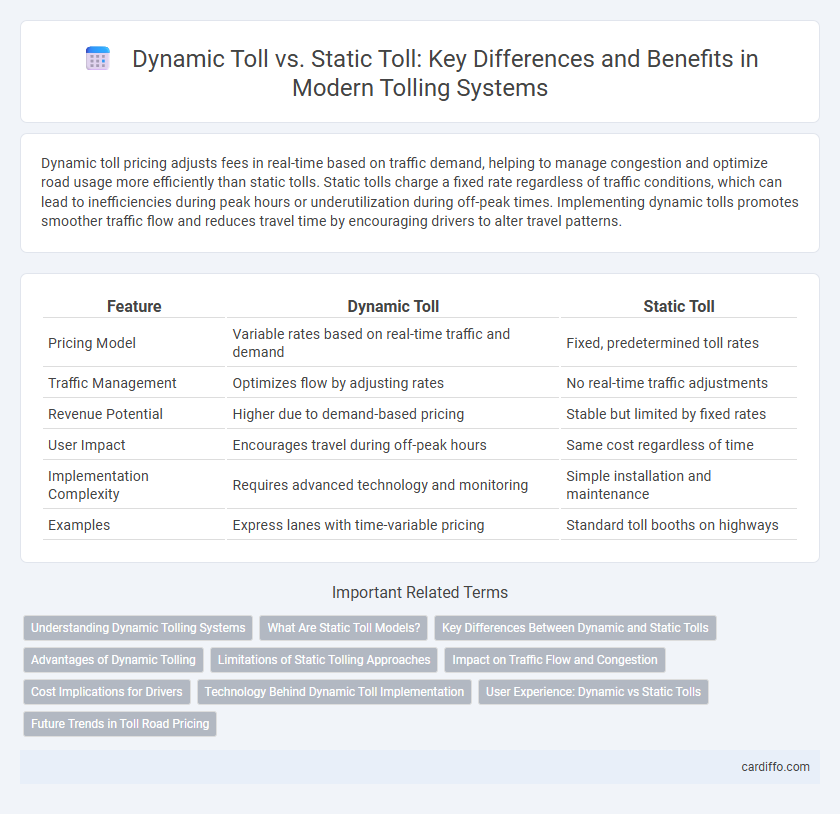Dynamic toll pricing adjusts fees in real-time based on traffic demand, helping to manage congestion and optimize road usage more efficiently than static tolls. Static tolls charge a fixed rate regardless of traffic conditions, which can lead to inefficiencies during peak hours or underutilization during off-peak times. Implementing dynamic tolls promotes smoother traffic flow and reduces travel time by encouraging drivers to alter travel patterns.
Table of Comparison
| Feature | Dynamic Toll | Static Toll |
|---|---|---|
| Pricing Model | Variable rates based on real-time traffic and demand | Fixed, predetermined toll rates |
| Traffic Management | Optimizes flow by adjusting rates | No real-time traffic adjustments |
| Revenue Potential | Higher due to demand-based pricing | Stable but limited by fixed rates |
| User Impact | Encourages travel during off-peak hours | Same cost regardless of time |
| Implementation Complexity | Requires advanced technology and monitoring | Simple installation and maintenance |
| Examples | Express lanes with time-variable pricing | Standard toll booths on highways |
Understanding Dynamic Tolling Systems
Dynamic tolling systems adjust fees in real-time based on traffic congestion, demand, and time of day, optimizing road usage and reducing traffic jams. Unlike static tolls that charge a fixed rate regardless of conditions, dynamic tolls use sensors and data analytics to balance traffic flow efficiently. This approach encourages off-peak travel and maximizes roadway capacity, enhancing overall transportation management.
What Are Static Toll Models?
Static toll models involve fixed toll rates that remain constant regardless of traffic conditions or time of day, providing predictable costs for drivers. These models simplify toll collection and planning but may not effectively manage congestion during peak hours. By contrast, dynamic toll models adjust prices based on real-time traffic data to optimize road usage and reduce congestion.
Key Differences Between Dynamic and Static Tolls
Dynamic tolls adjust pricing based on real-time traffic conditions, aiming to manage congestion and optimize road usage efficiency. Static tolls maintain fixed rates regardless of traffic fluctuations, providing predictable costs but less flexibility in traffic control. The key difference lies in dynamic tolls' responsive pricing model versus static tolls' constant rate approach.
Advantages of Dynamic Tolling
Dynamic tolling optimizes traffic flow by adjusting prices based on real-time demand, reducing congestion and improving travel time reliability. It encourages off-peak travel, leading to more efficient roadway utilization and lower emissions. Compared to static tolling, dynamic tolling offers greater flexibility and revenue generation potential aligned with actual traffic conditions.
Limitations of Static Tolling Approaches
Static tolling approaches typically fail to adapt to real-time traffic fluctuations, resulting in inefficient congestion management and suboptimal roadway usage. These fixed toll rates can lead to increased traffic during peak hours and underutilization during off-peak times, limiting their effectiveness in demand-responsive pricing strategies. The inability to dynamically adjust prices restricts revenue optimization and hinders the implementation of equitable tolling systems.
Impact on Traffic Flow and Congestion
Dynamic tolling adjusts prices based on real-time traffic conditions, effectively reducing congestion during peak hours by discouraging excessive demand and promoting smoother traffic flow. Static tolls, set at fixed rates regardless of traffic volume, often fail to adapt to varying congestion levels, leading to persistent bottlenecks and slower travel times. Implementing dynamic toll systems enhances roadway efficiency and minimizes traffic delays compared to static tolling methods.
Cost Implications for Drivers
Dynamic toll pricing adjusts charges based on real-time traffic conditions, often leading to higher costs during peak hours but potentially lower fees during off-peak times, benefiting drivers who travel at less congested periods. Static toll pricing sets a fixed rate regardless of traffic, providing predictable costs but possibly resulting in overpayment during low-demand times. Drivers choosing dynamic tolls may experience cost savings through flexible travel times but face unpredictability, while those opting for static tolls trade off convenience and certainty for potentially higher expenses during rush hours.
Technology Behind Dynamic Toll Implementation
Dynamic toll systems leverage real-time traffic data, advanced sensors, and AI algorithms to automatically adjust toll rates based on congestion levels and traffic flow patterns. These technologies enable dynamic pricing models that optimize road usage, reduce traffic jams, and improve overall transportation efficiency. In contrast, static tolls rely on fixed pricing without considering current traffic conditions, lacking the adaptability provided by dynamic toll technology.
User Experience: Dynamic vs Static Tolls
Dynamic toll pricing enhances user experience by adjusting rates based on real-time traffic conditions, reducing congestion and travel time. Static tolls maintain fixed fees regardless of demand, often leading to predictable but potentially inefficient traffic flow. Drivers benefit from dynamic tolls through more flexible and cost-effective route choices, improving overall satisfaction and road network efficiency.
Future Trends in Toll Road Pricing
Dynamic toll pricing leverages real-time traffic data and advanced algorithms to adjust rates based on congestion levels, optimizing road usage and reducing delays. Static toll systems maintain fixed prices regardless of traffic variations, often leading to inefficiencies during peak hours. Future trends emphasize integrating AI-driven predictive models and IoT sensors to enhance dynamic tolling accuracy, promoting smarter transportation networks and sustainable traffic management.
Dynamic Toll vs Static Toll Infographic

 cardiffo.com
cardiffo.com